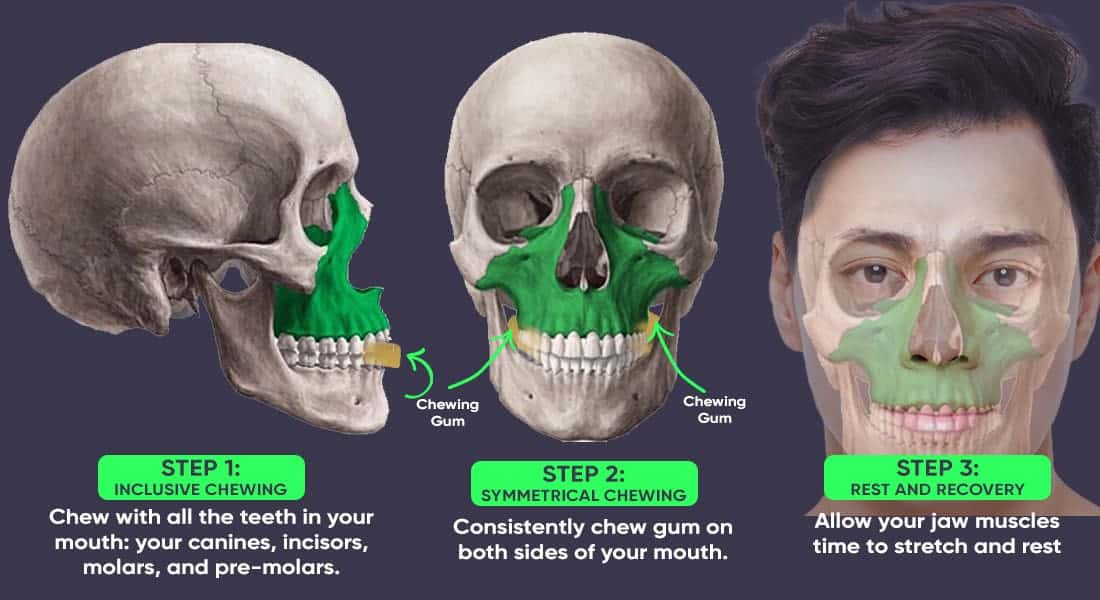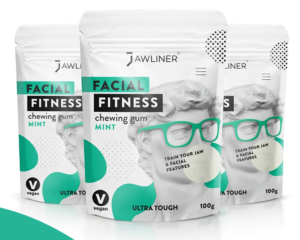
Why Does My Jaw Hurt When I Chew?
If you’ve ever experienced your jaw freezing while chewing gum, you’re not alone.
A review of facts related to chewing gum and its excessive use suggests that it can indeed have a significant influence on oral health. Chewing gum offers various benefits, including enhanced cognition, stress relief, and a more defined jawline. Explore our detailed blog post for further insights into the relationship between chewing gum and sharper jawline.
Even with all those pros, jaw pain might be one of the cons of using chewing gum. Let’s delve into solutions for that uncomfortable jaw pain when chewing gum.
What Are the Risks of Gum Chewing with TMJ?
Chewing gum can impact the temporomandibular joint (TMJ) and overall oral health in both positive and negative ways. While moderate chewing can help relax jaw muscles, excessive chewing tightens these muscles and stresses the joint, potentially causing discomfort and pain.
Repetitive chewing can worsen existing TMJ symptoms and contribute to TMJ disorder (TMD). Consistently chewing on one side of the mouth can create uneven force distribution, causing overworked muscles, and leading to severe pain, discomfort, and headaches.
For preventing jaw pain on one side and other potential TMJ issues, limit gum chewing, especially if you have existing jaw problems. If you experience jaw pain or TMJ symptoms, consult a dentist or oral surgeon for a proper diagnosis and treatment plan.
How to Stop Jaw Pain From Chewing Gum
Chewing gum can be a refreshing treat, but if your jaw is protesting your gum habit, don’t worry! From gentle jaw exercises for jaw pain relief and ice compress to over-the-counter pain relievers, there are several solutions for relief. We’ll explore techniques to ease the discomfort and get you back to pain-free chewing.
When your jaw hurts, the first thing you need to do is to give your jaw a break! Rest it by avoiding strenuous activities like chewing gum and hard foods. This allows your overworked muscles to relax and recover. Read on to learn some helpful strategies to further promote healing.
Solution 1: Mewing Technique
Mewing is a technique that aims to improve oral posture by consciously positioning the tongue against the roof of the mouth. While it’s primarily associated with enhancing facial aesthetics, it may also offer relief for TMJ-related issues, such as when patients have difficulty opening and closing their jaw. Benefits of mewing include achieving proper jaw alignment and balanced muscle activity, which leads to reduced tension and improved facial symmetry.
Effective mewing practices include maintaining gentle tongue-to-palate contact, prioritizing nasal breathing, and incorporating chin tucking for a neutral head position. Consistency is key— and you need to integrate mewing into daily activities to maximize its benefits. Refer to our ultimate mewing guide for tips on successful mewing practice.
The Mewing Coach app is your ultimate companion for mastering the mewing technique. With customizable daily reminders and posture alerts, the app offers a comprehensive solution, ensuring consistent practice. You can get an effective mewing workout plan tailored for TMJ management. Try our app today to ensure a successful mewing journey.
Solution 2: Limit Chewing Duration and Frequency
To prevent jaw strain and discomfort, it’s crucial to limit both the duration and frequency of gum chewing. Excessive chewing can overwork the jaw muscles, leading to tension and pain.
Reduce gum chewing frequency by opting for sugar-free alternatives or limiting chewing sessions to specific times of the day. Prioritize moderation to maintain optimal jaw health and comfort.
Solution 3: Chew Gum That’s Sugar-Free

Sugar-free gum is an excellent choice to reduce jaw strain while still enjoying the benefits of chewing. It can help alleviate jaw pain by engaging your jaw muscles without the added sugars found in regular gum.
Jawliner sugar-free gum is specifically designed to target your jaw and facial muscles. By consistently chewing this gum, you engage these muscles, which can help build facial muscle strength and enhance jawline definition.
Unlike regular gum, Jawliner is sugar-free and vegan, making it a more health-conscious option. You can enjoy the benefits of chewing without worrying about added sugars. Jawliner has a significantly harder texture compared to regular gum. This hardness provides a challenging workout for your jaw muscles, helping to relieve tension and strain.
Solution 4: Practice Proper Chewing Technique
By incorporating proper chewing techniques, you can chew gum without putting undue stress on your jaw. Avoid clenching your jaw while chewing as it can result in TMJ syndrome. Keep your jaw relaxed and focus on the movement of your teeth grinding the gum. Distribute the workload by consciously chewing evenly on both sides of your mouth. This prevents one side from getting overworked and fatigued.
Savor the flavor and texture of the gum. Avoid rushing through the process, which can lead to tenser muscles.
Solution 5: Apply a Warm Compress
Sore jaw muscles often respond well to the soothing power of heat. Moisten a clean washcloth with warm water. Place the warm compress on the affected area of your jaw for 10-15 minutes. The warmth helps relax tense muscles and improve blood circulation, promoting healing and reducing pain.
Repeat this process several times a day, as needed.
Caution: Avoid using excessively hot compresses, as this can cause burns.
Solution 6: Perform Gentle Jaw Exercises
Incorporating gentle jaw exercises can significantly improve your comfort and jaw mobility. Here are a few simple exercises you can try at home:
- Jaw stretches: Open your mouth slowly and comfortably as wide as you can. Hold for a few seconds, then slowly close your mouth. Repeat 5-10 times.
- Side-to-side jaw movement: Gently move your jaw side-to-side, feeling the stretch in your jaw muscles. Repeat 5-10 times on each side.
- Jaw massage: Gently massage the muscles around your jaw with your fingertips in a circular motion. This can help to relax tense muscles and improve circulation.
Explore more jawline exercises for a more defined look.
Solution 7: Avoid Hard or Chewy Foods
While gum can be a culprit, other foods can also put a strain on your jaw muscles, especially when you’re already experiencing pain.
Chewing on hard foods like nuts, raw vegetables, and hard candy requires significant jaw force. This can exacerbate existing pain and slow down the healing process. Chewy foods like steak, chewy candy, and bagels require sustained chewing, which can fatigue your jaw muscles and worsen discomfort. It is also important to avoid gum for a while until pain subsides.
By giving your jaw a break from these challenging foods, you’ll allow your muscles to recover faster and prevent further irritation.
Solution 8: Seek Medical Attention
While most jaw pain from chewing gum resolves with home care, there are times when seeking medical attention is crucial as it could be a sign of an underlying oral condition. Here’s when to schedule a visit with your dentist or doctor:
- Persistent pain: If your jaw pain persists for more than a few days, even with home remedies, it’s best to get a professional evaluation.
- Severe pain: Severe pain that interferes with daily activities like eating or speaking is one of the notable signs that you are suffering from TMJ, and it requires a professional assessment.
- Limited jaw movement: Difficulty opening or closing your mouth fully could indicate a more serious issue.
- Locking jaw: If your jaw becomes locked in a fixed position, seek immediate medical attention.
These symptoms mean that you might be having various underlying conditions like temporomandibular joint dysfunction (TMJ) or even infection. Early diagnosis and treatment can prevent complications and ensure a faster recovery.
Conclusion
To combat jaw pain from chewing gum, embrace solutions like the Mewing technique and limit chewing frequency with sugar-free gums for jawline, such as Jawliner gum. Practice proper chewing techniques, apply warm compresses, and engage in gentle jaw exercises to reduce muscle tension. Avoid hard or chewy foods that strain your jaw muscles.
It is highly recommended to seek medical attention if symptoms persist, as you might be having an underlying issue such as a joint disorder or TMJ syndrome.
Remember, these strategies can enhance comfort and promote jaw health, so don’t hesitate to give them a try. Take charge of your jaw health today with these effective remedies. If discomfort persists, consult a healthcare professional for personalized guidance and care.



